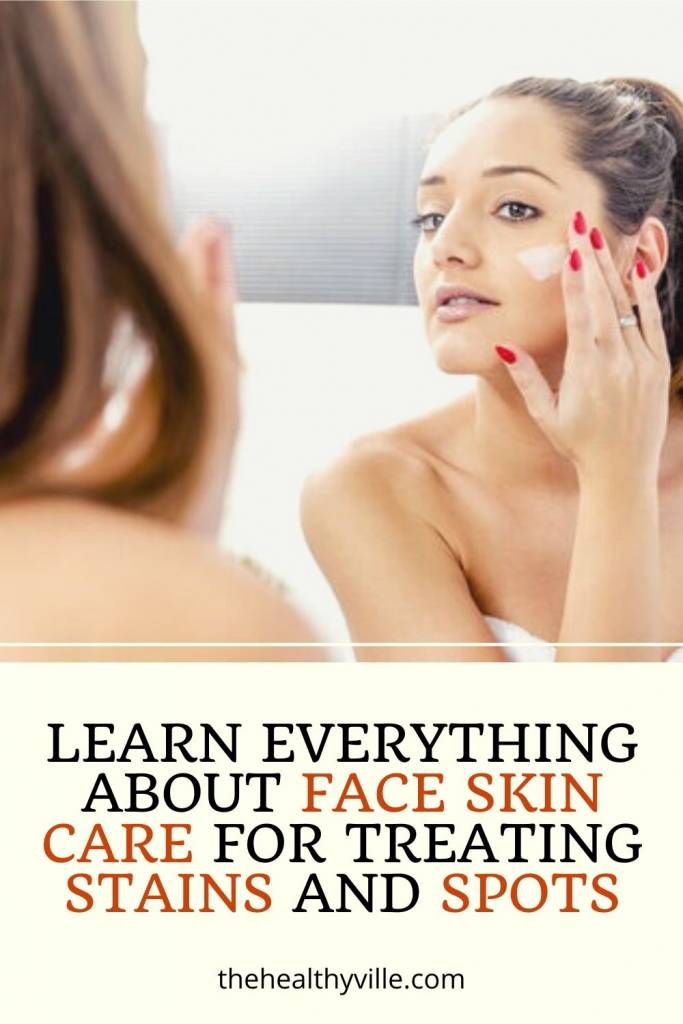You may know a little about face skin care and how to treat spots and stains on your face. But here, you will learn a lot about it, and you’ll literally have a spotless face.
The spots frequently appear on the face, neckline or hands. To combat them, in addition to resorting to anti-stain creams, it is essential to use sunscreen throughout the year.
The effect of stain creams depends on the type of stain you are treating. To get results you have to be constant and always combine them with sun protection, although some of them can only be used at night.
Anti-stain creams are formulated with depigmenting active ingredients that slow down the production of melanin and stimulate cell regeneration.
Types of hyperpigmentation or spots
The spots usually appear on the face, neckline or hands. To combat them, in addition to resorting to anti-stain creams, it is essential to use sunscreen throughout the year. Hyperpigmentations are classified into two types:
- Melanes: they appear due to an increase in melanin production. Freckles, melasma or hyperpigmentation due to inflammation are included in this group. Anti-stain creams can be used for this type.
- Melanocytic: they are due to an increase in the number of melanocytes. This includes senile lentigines, simple lentigines and moles. This variety does not undergo changes with anti-stain creams.
Most frequent spots on the skin
The spots that appear on the skin most frequently are:
- Solar lentigines: these are sun spots that form flat plates larger than freckles.
- Freckles: they are small brown spots of irregular distribution.
- Chloasma or pregnancy mask: usually appears on the sides, front, upper part of the lip and on the cheeks. It is also known as chloasma gravidarum.
- Berloque dermatitis: spots that appear on the neck due to the use of certain perfumes.
- Scar or post-inflammatory hyperpigmentation after acne lesions, herpes zoster or allergic contact dermatitis.
What ingredients do anti-stain creams contain?
Anti-stain creams come in different forms: emulsion, gel, serum, hydroalcoholic solution and mask. In this way, it is easy for them to adapt to all skin types.
There are different active ingredients that are part of the composition of depigmenting creams, and that you will see on their label. They include:
- Antioxidants: such as vitamin C, in 5-15%.
- Mequinol: it is used in 2-10% and produces a reversible depigmentation of the skin by preventing the metabolic processes of melanocytes.
- Azelaic acid: it is used 10-20% and is an antibacterial.
- 5% Niacinamide.
- Kojic acid.
- Vegetable extracts: from bearberry, arbutin, licorice, chamomile or mulberry.
- Acids: like phytic at 1-2%, alfalipoic in proportion of 2-8% and ellagic at 1%.
- Alpha hydroxy acids: they have the function of exfoliating the skin to minimize the appearance of spots.
- Keratolytics: as salicylic acid.
In addition to those mentioned, other ingredients that require a medical prescription can be incorporated, such as retinoic acid and hydroquinone.
Combine anti-stain creams with sunscreen
The spots on the skin are not all the same. Depending on the type presented, it will be the effectiveness or not of an anti-stain cream.
The spots are a chronic process that worsens with the arrival of good weather and sun exposure. However, they improve or disappear during the autumn and winter months. You should know that, in the spring and summer months, you should apply the sunscreen half an hour before sun exposure, and replicate it every two hours.
It is also advisable to reapply it if you take a bath or practice an intense sports activity. Remember the importance of using sunscreen daily, and that this turns out to be the best anti-aging cream.
About face skin care and the application of anti-stain skin products
The general pattern of use is once a day at night, for one or two weeks, until the skin becomes accustomed. It is normal to notice a slight stinging in the first applications, however, if the irritation persists you should stop using it.
Subsequently, continue applying it twice a day for at least two months, to see results. Depigmenting creams that need a prescription are usually more irritating and photosensitizing, so the doctor usually recommends their application at night.
Once you achieve the desired result, it is advisable to continue with a maintenance regime by applying it twice a week and photoprotection daily. You can improve the results by using food supplements that help improve the condition of the skin, prevent the appearance of new spots and reduce existing ones.
Read more: Get Rid Of Blemishes And Freckles On Arms Using This Natural Mask!
Conclusion
Anti-stain creams help reduce stains and equalize skin tone. However, the result obtained with the treatment depends largely on your use of the sunscreen.
It is also important that you correctly identify the stain. While some do not improve with the application of creams, there are others that do. If in doubt, you should consult a dermatological professional.
Don’t forget to SHARE everything you’ve learned about face skin care with your friends and family on your social networks!

